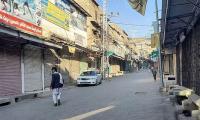Though Pakistan’s economy has rarely been on stable grounds, for the past three years we have been on a rollercoaster ride most of the time. The exchange rate has been fluctuating and now the US dollar is touching the 167 rupees mark showing a considerable depreciation of Pak currency since 2018. In the beginning of 2018, one dollar traded for 110 rupees; that means nearly 50 percent depreciation of Pak rupee has taken place in such a short period of time. Then there is the question of rising current account deficit (CAD) and surging import expenditures that drain the foreign exchange from the country. The growth that the government claims appears to be fragile. Moreover, there has been more import of consumer goods rather than chemicals or machinery that contribute to the manufacturing sector in the country. Due to some misplaced policies of the government the market for real estate, luxury cars, and expensive foreign products is booming.
A large portion of our import bill goes to purchasing unnecessary items that cause an unmanageable gap between imports and exports. Since 2020, we have seen a consistent surge in recurring current account deficit. Whatever minor recovery the government claimed appears to have evaporated. When a country’s currency comes under pressure for any reason, mostly this is due to recurring current account deficits. The demand for foreign currency has risen and puts the local currency under strain which is in this case undue and should have been managed much earlier. Perhaps the repeated replacements in the top economic and financial team of the government have also had an adverse impact on timely decision-making. The managers of the economy must realize that the demand for the dollar has to subside, failing which further depreciation may be in store for us. That means more inflation for the citizens of Pakistan.
Apart from inflation, with increasing CAD and depreciating rupee, the debt liability of the country also increases in an uncontrollable manner, if timely decisions are delayed. A budget deficit of over seven percent of the GDP indicates slower growth in revenues which are compounded by higher expenditures that also include debt servicing. No matter how hard our ministers and economic managers try to look upbeat and portray a rosy picture about the performance of the economy, the fact remains that the deficit is much higher than expected. A CAD of two to three percent of the GDP may be sustainable but anything higher than that is bad news for the economy and for the people who are the ultimate victims of this mismanagement. They simply cannot afford any more destabilization in the economy. The detrimental policies must be reversed or at least contained on a priority basis. If we keep falling into the abyss of unsustainable debts set up by international lending institutions, it is essentially the government that will be held responsible in the end.
PTA’s says foreign investment in local telecom sector has been declining despite jump in broadband subscribers
Cumulative impact has been to make jobs of those in industry today harder and riskier than ever
Govt's hawkish elements need to recognise that their rigidity could worsen the current political impasse
These sentences mark first phase of legal consequences for those involved
Deadlock finally broken on Thursday , with India, Pakistan and ICC agreeing to hybrid model
No one enjoys giving up portion of their income and so revenue collection measures incur people’s resentment







